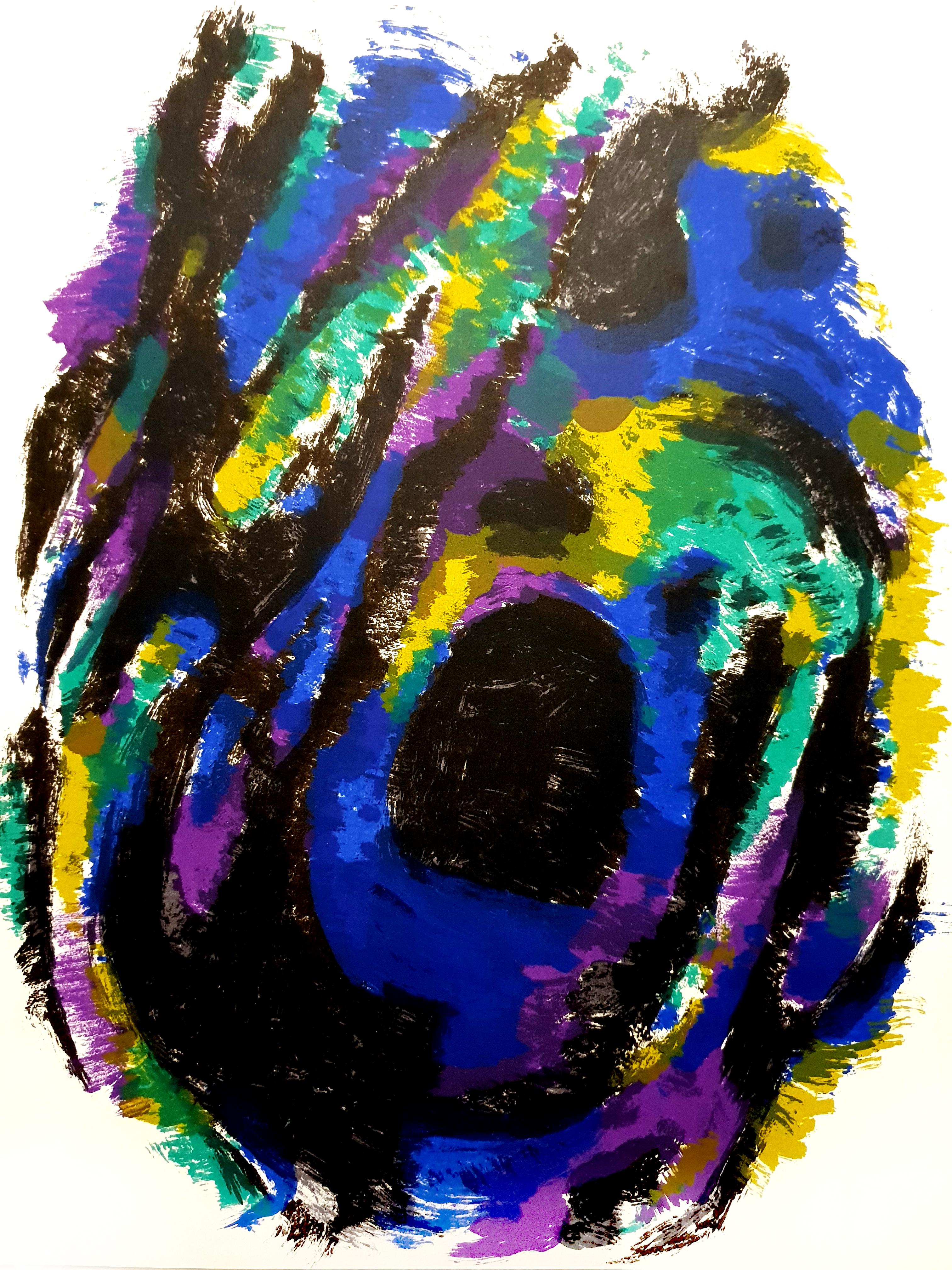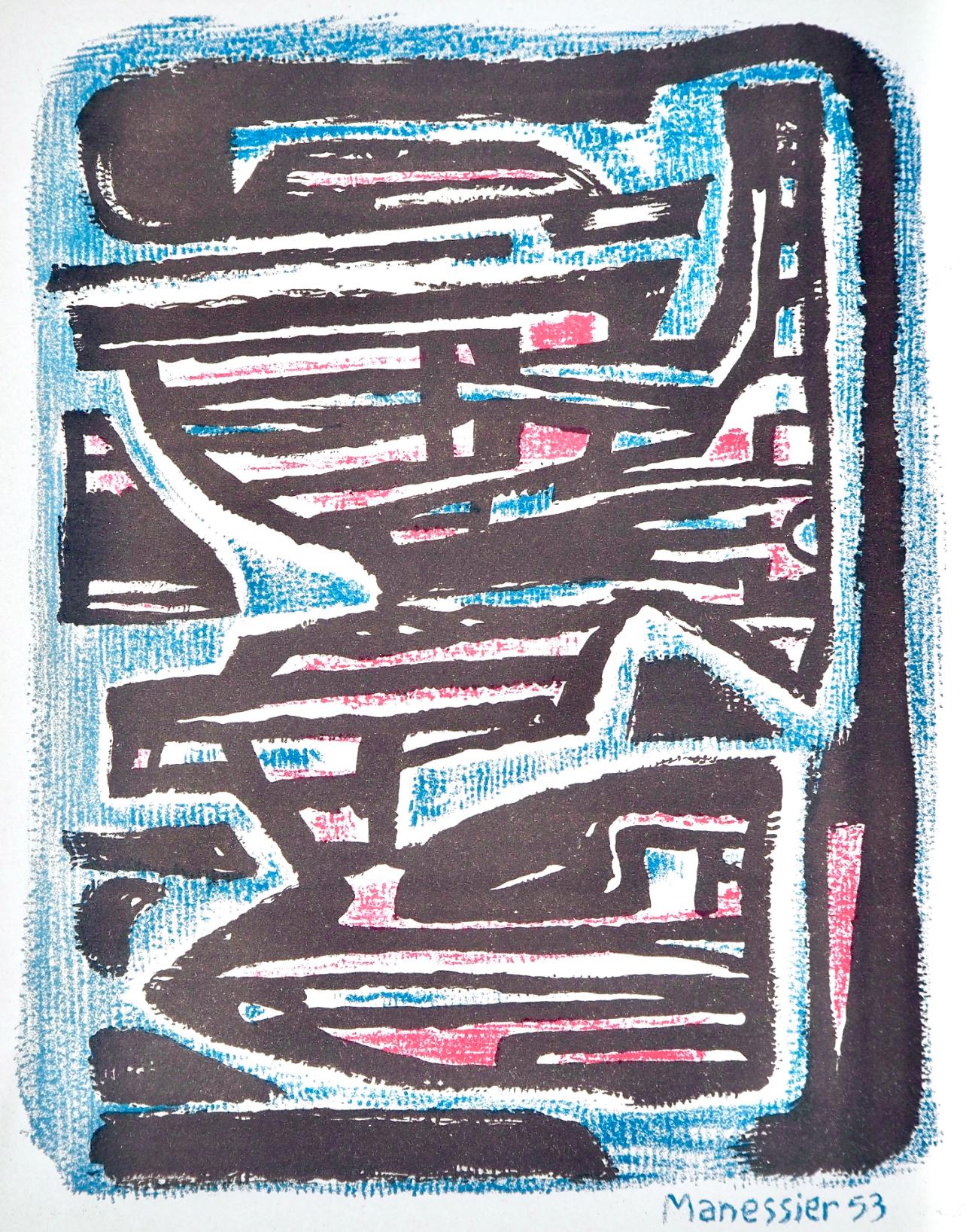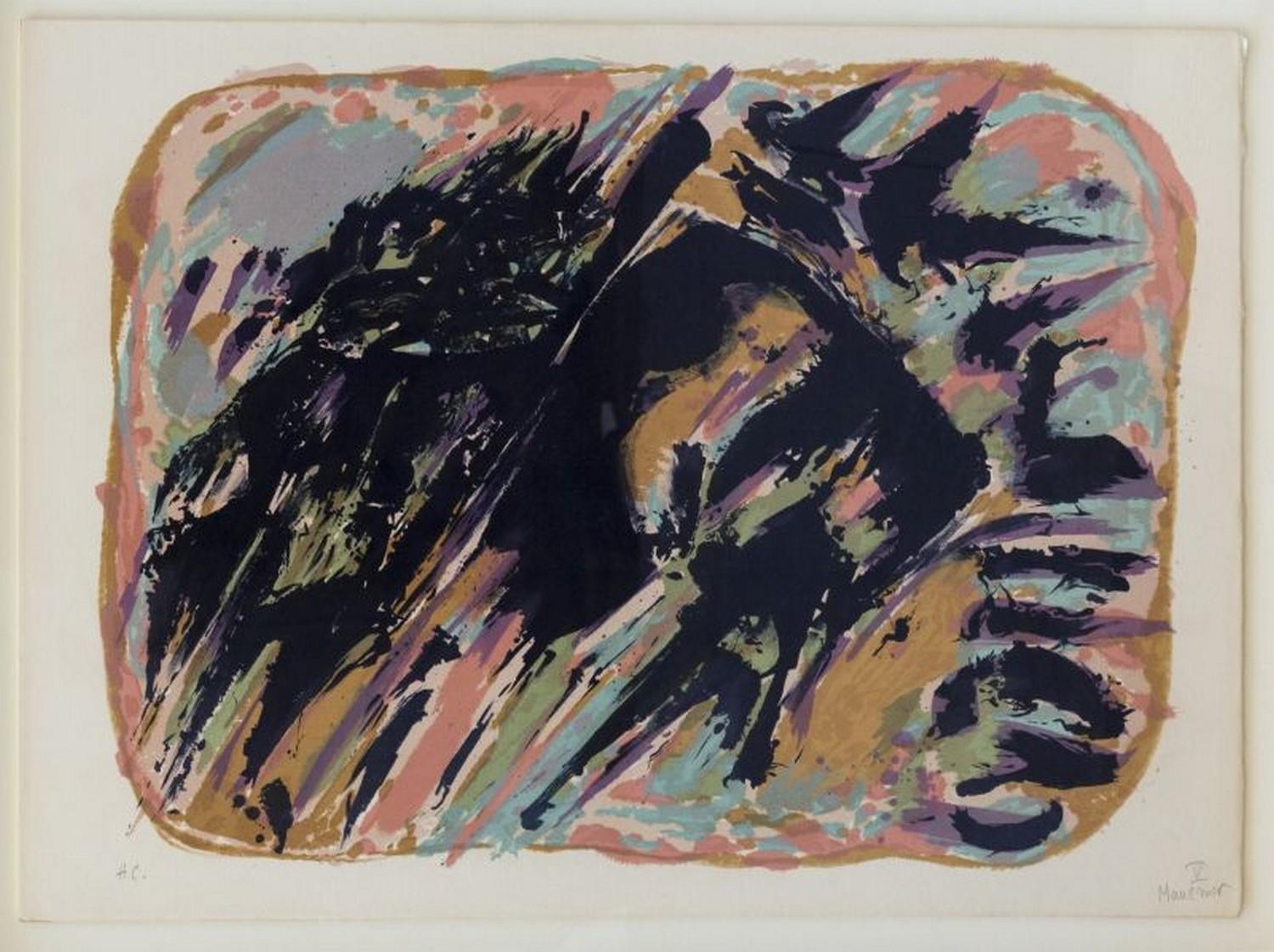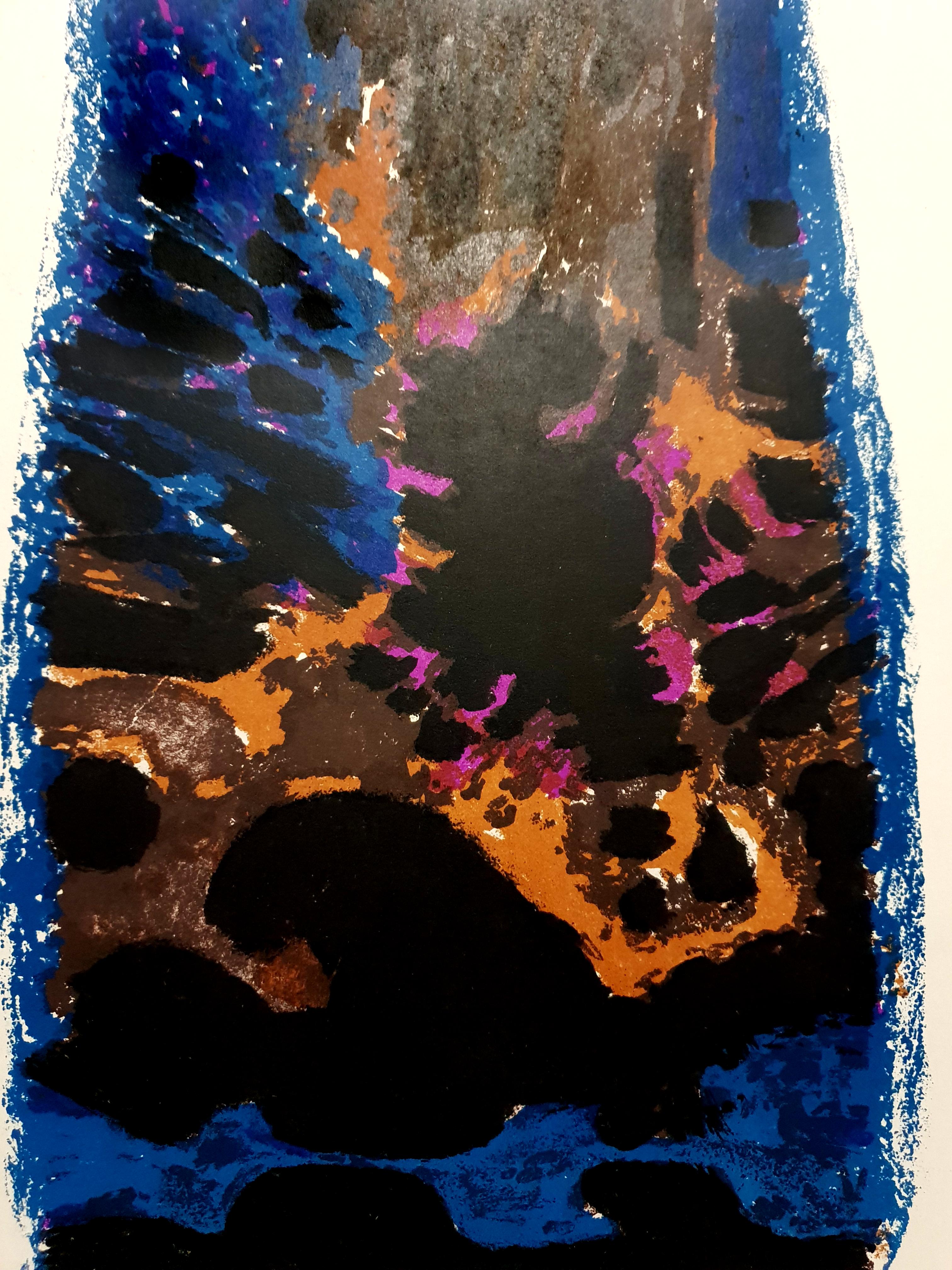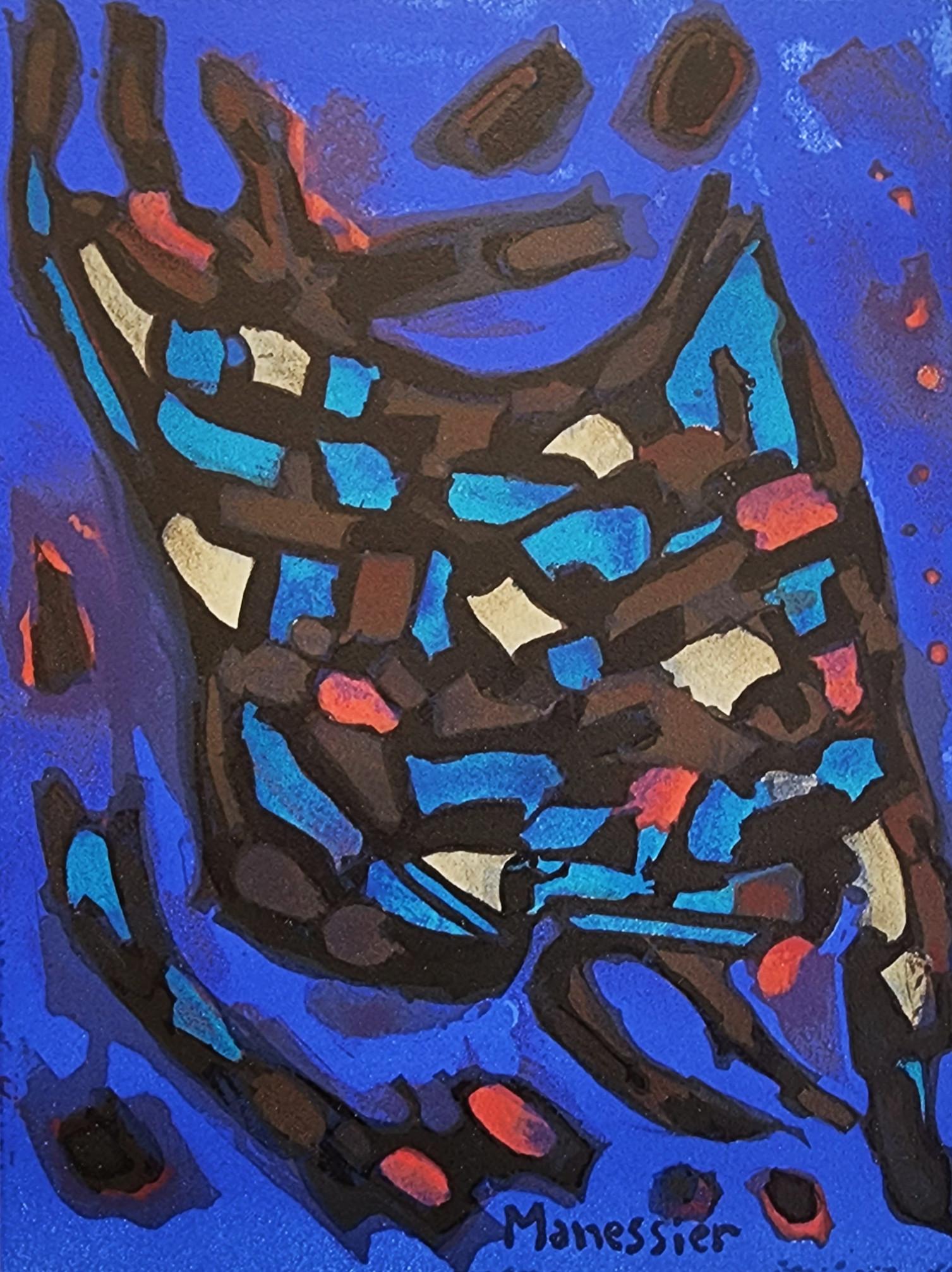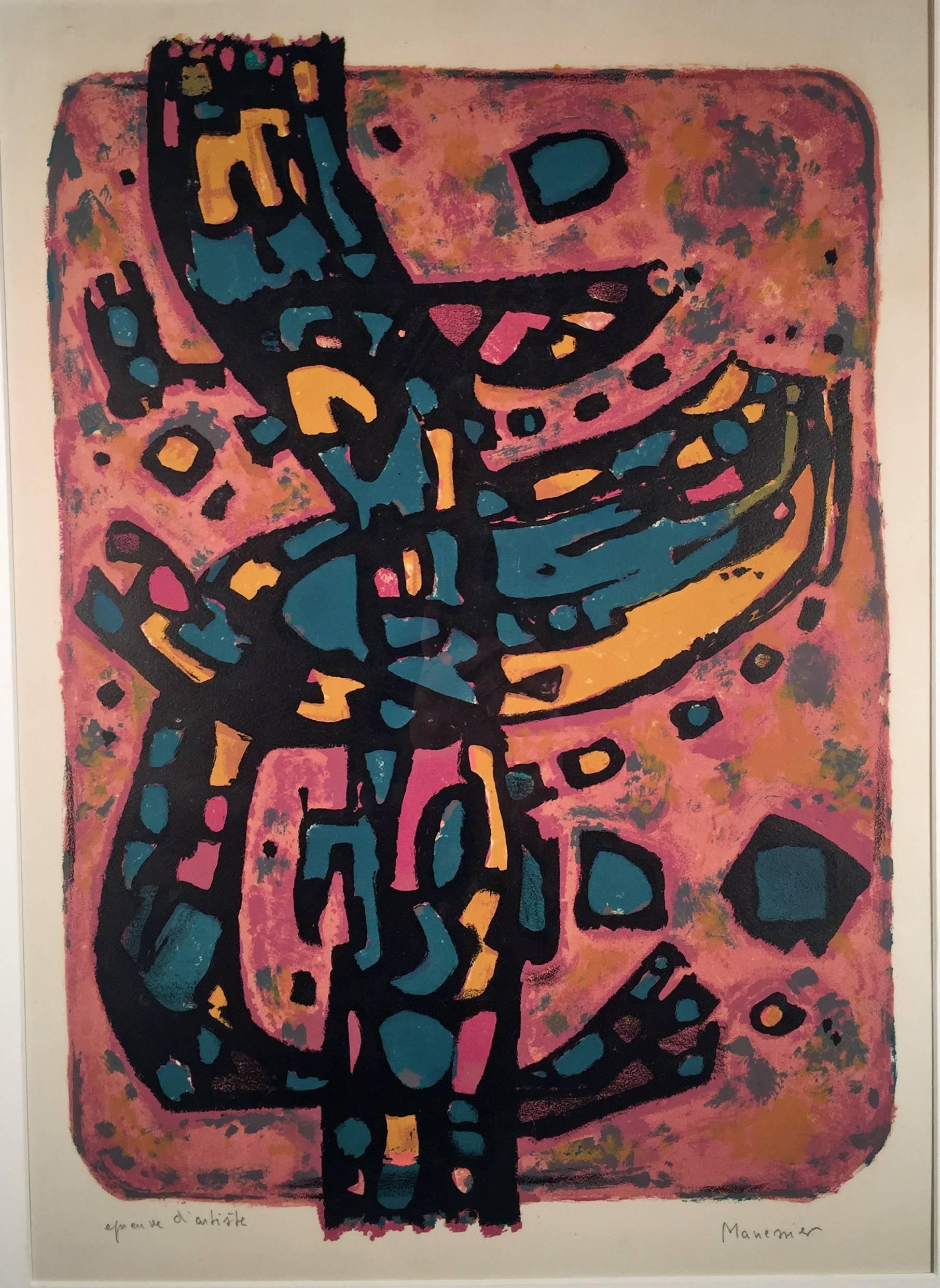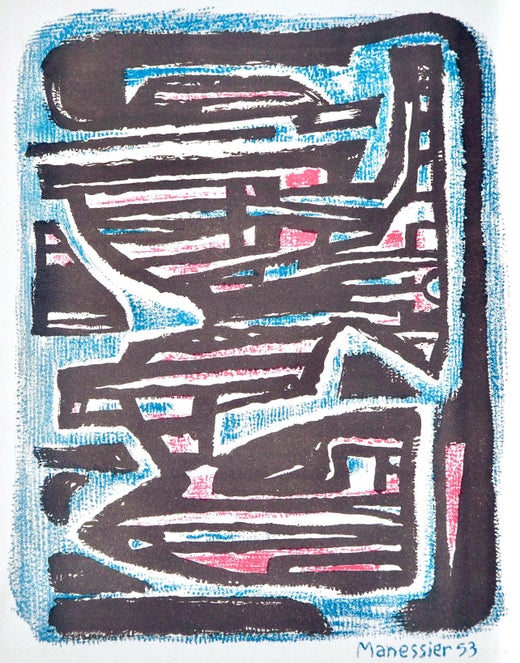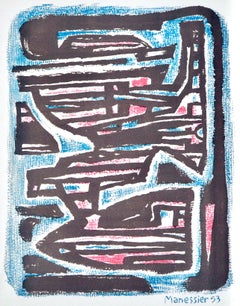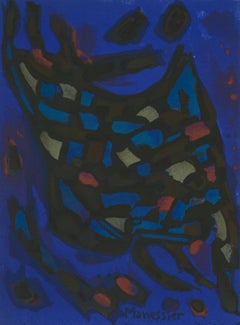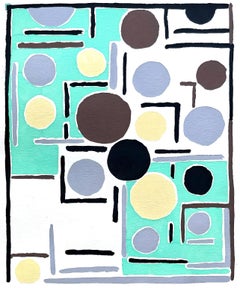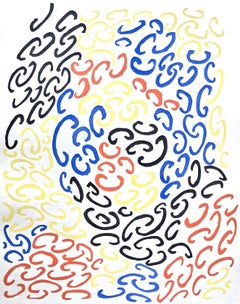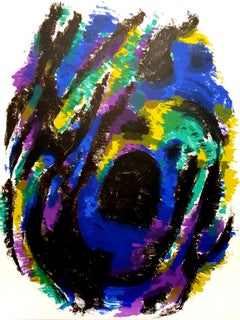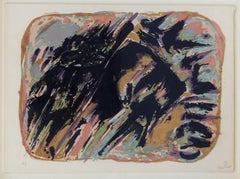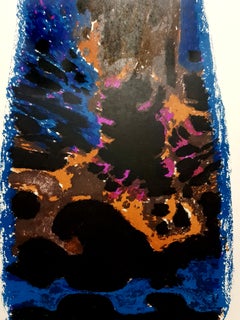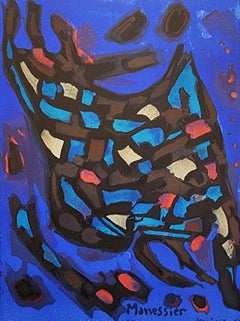Objekte ähnlich wie Le Nid, Petite tache noire n°1, Société internationale d'art XXe siècle
Möchten Sie mehr Bilder oder Videos?
Zusätzliche Bilder oder Videos von dem*der Anbieter*in anfordern
1 von 7
Alfred ManessierLe Nid, Petite tache noire n°1, Société internationale d'art XXe siècle1960
1960
618,61 €
773,27 €20 % Rabatt
Angaben zum Objekt
Lithographie auf Velinpapier. Papierformat: 12,4 x 9,65 Zoll. Beschriftung: Unsigniert und nicht nummeriert, wie ausgegeben. Anmerkungen: Aus dem Album, XXe siècle, Nouvelle série, XXIIe Année, N° 15, Noël 1960, Cahiers d'Art publiés sous la direction de Gualtieri di San Lazzaro, 1960. Herausgegeben von der Société Internationale d'Art XXe siècle, Paris, unter der Leitung von Gualtieri di San Lazzaro, éditeur, Paris; gedruckt von Mourlot Frères, Paris, 1960. Zusätzliche Hinweise: Auszug aus dem wissenschaftlichen Artikel "Promoting Original Prints, The Role of Gualtieri di San Lazzaro and XXe Siècle" von Valery Holman, veröffentlicht in Print Quarterly, XXXIII, 2016, 2, Bis vor kurzem wurde sehr wenig über den italienischen Autor und Kunstverleger Gualtieri di San Lazzaro (1904-75) geschrieben, Dabei hat er 50 Jahre lang über Leben und Werk zeitgenössischer Künstler berichtet, Monografien von außergewöhnlicher Qualität herausgegeben und Originaldrucke moderner Maler und Bildhauer über seine bekannteste Zeitschrift XXe Siècle verbreitet. Obwohl er im Vereinigten Königreich immer noch relativ unbekannt ist, gehört San Lazzaro zu dem halben Dutzend großer Kunstverleger aus der Mitte des 20. Jahrhunderts, der sich zusammen mit seinem Vorbild Ambroise Vollard (1866-1939) und den Verlegern seiner eigenen Generation, Christian Zervos (1889-1970), Tériade (1889-1983) und Albert Skira (1904-73), in Paris niedergelassen hat, das er zeitlebens als das Zentrum der Kunstwelt betrachtete....XXe Siècle, eine illustrierte Zeitschrift, wurde 1938 ins Leben gerufen und in einer Auflage von etwa 2.000 Exemplaren gedruckt. Jede Ausgabe enthielt sowohl Fotografien als auch vierfarbige Reproduktionen, die ein breites Spektrum visueller Darstellungen abdeckten, von Meisterwerken der westlichen Malerei bis hin zu populären Grafiken aus dem Fernen Osten. Das große Format, das lebendige Design und die enge Verzahnung von Text und Bild fielen sofort ins Auge, aber das innovativste Merkmal, das auf Anregung von Hans Arp (1886-1966) eingeführt wurde, war die Aufnahme von Originaldrucken zeitgenössischer Künstler in jede Ausgabe. XXe Siècle richtet sich nicht nur an Sammler, sondern soll auch ein breiteres internationales Publikum mit zeitgenössischer Malerei und Bildhauerei bekannt machen, und zwar durch hochwertige Farbreproduktionen und die Unmittelbarkeit von Originaldrucken. Preislich vergleichbar mit den Cahiers d'Art, waren die ersten Ausgaben von XXe Siècle schnell vergriffen. Während San Lazzaros eigene ästhetische Vorlieben zur lyrischen Abstraktion tendierten, stellte er klar, dass XXe Siècle überparteilich war [die Veröffentlichung wurde während des Zweiten Weltkriegs eingestellt]. .... 1951 startete San Lazzaro XXe Siècle neu mit Themen, die auf MATERIALEN basierten oder sich auf ein aktuelles Thema in der bildenden Kunst, insbesondere in Europa, konzentrierten: Konzepte des Raums, der Materie, der Monochromie, des Markierens und des Zeichens". Denn während sich San Laz-zaro ursprünglich auf Pariser Maler und Bildhauer konzentriert hatte, wollte er ein internationales Netzwerk schaffen, um die Werke französischer Künstler in Italien und italienischer Künstler in Frankreich bekannt zu machen und diese bilaterale Achse später auf die englischsprachige Welt auszudehnen. Die Künstler, die in Nr. I mit einem Originaldruck vertreten sind, waren alle vor allem als Bildhauer bekannt: Arp, Laurens, Henry Moore (1898-186) und Marino Marini. San Lazzaro wollte den Lesern nicht nur die ganze Bandbreite des Schaffens eines Künstlers vor Augen führen, sondern auch zur Herstellung von Druckgrafiken anregen, eine Anregung, die zum Beispiel von Magnelli.... sehr geschätzt wurde Aufgrund seines schlechten Gesundheitszustands verlor San Lazzaro 1968 die Kontrolle über XXe Siècle an Léon Amiel, einen Drucker und Verleger, der ihn finanziell unterstützte und beim Vertrieb in Amerika half." Die thematischen Ausgaben wurden eingestellt und durch ein "Panorama" des Jahres ersetzt, aber San Lazzaro war weiterhin als Verleger von Büchern und Alben mit Grafiken tätig..... Kurz nach seinem Tod war San Lazzaro selbst Gegenstand zweier Ausstellungen: Die Ausstellung "Omaggio a XXe Siècle" im Dezember 1974 in Mailand stellte das grafische Werk der Künstler in den Mittelpunkt, die ihm in seinem späten Leben am nächsten standen, während die Ausstellung "San Laz-zaro et ses Amis" 1975 im Musée d'Art Moderne de la Ville de Paris Werke all derer zeigte, die er mehr als 50 Jahre lang gefördert hatte: Arp, Calder (1898-1976), Capogrossi, Chagall, Sonia Delau-nay, Dubuffet, Estève, Lucio Fontana (1899-1968), Gili-oli (1911-77), Magnelli, Marini, Miró, Moore und Poliakoff. Einer seiner engsten Mitarbeiter sah in dieser Ausstellung ein indirektes Porträt von San Lazzaro, einem vielschichtigen Menschen, dessen Bescheidenheit und Zurückhaltung sein unermüdliches Bestreben verbarg, die internationale Wertschätzung für zeitgenössische Kunst zu erhöhen und dem lesenden Publikum die Entstehung dieser Kunst durch das Medium der Druckschrift näher zu bringen.
ALFRED MANESSIER (1911-1993) war ein nicht-figurativer französischer Maler, Glasmaler und Tapisserie-Designer, der zur Neuen Schule von Paris und zum Salon de Mai gehörte. Da er sich von der Natur seiner Heimatregion inspirieren ließ, begann Manessier schon früh, Landschaften zu malen. Seine formale Ausbildung erhielt er durch ein Architekturstudium, das er zunächst in Amiens und ab 1929 an der École des beaux-arts in Paris absolvierte. Manessier mochte die formale Atmosphäre der Schule nicht und zog es vor, Gemälde im Louvre zu kopieren - vor allem von alten Meistern wie Rembrandt van Rijn, Peter Paul Rubens und Tintoretto - und die Ateliers von Montparnasse zu besuchen. Außerdem studierte er 1935 kurz an der Académie Ranson bei Roger Bissière, der Manessier in die Freskotechnik einführte. In der Zeit vor dem Zweiten Weltkrieg spiegeln sich in seinen Bildern sowohl kubistische als auch surrealistische Einflüsse wider. Im Jahr 1939 wurde Manessier zum Militärdienst eingezogen.
In der Nachkriegszeit wird Manessier mit der Lyrischen Abstraktion (Abstraction lyrique) und der Informellen Kunst in Verbindung gebracht. Sein Werk entspricht jedoch auch einer spezifischen Strömung der französischen Kunst, die während der deutschen Besatzung aufkam und christliche Themen und Symbolik in halbabstrakte Kompositionen einbezog. Der katholische Maler Jean Bazaine, ein starker Befürworter der "art sacré" (heilige Kunst), nahm Manessiers Werke in die berühmte Ausstellung "Vingt jeunes peintres de tradition française" (Zwanzig junge Maler der französischen Tradition, 1941) auf, die in der Galerie Braun in Paris organisiert wurde, um den Nazis zu trotzen. 1943 erlebte Manessier ein religiöses Erwachen während eines dreitägigen Aufenthaltes in einem Trappistenkloster. Bald darauf konvertierte er zum römischen Katholizismus und begann, einen zunehmend asketischen Lebensstil zu führen. Ab 1945 erinnern seine Kompositionen an Glasfenster und werden abstrakter, obwohl weiterhin figurative Elemente mit Bezug zu Religion und Landschaft auftauchen. Seine Gemälde spielen durch ihre Titel und durch Kombinationen aus erkennbaren Symbolen und abstrakten Bildern auf religiöse Bedeutungen an.
Manessier erlangte zunächst internationale Anerkennung für seine Gemälde, beherrschte aber eine Vielzahl von Medien, darunter Lithografie, sowie Entwürfe für Wandteppiche, liturgische Gegenstände und Gewänder. Auf Drängen von Georges Rouault begann Manessier 1948 mit der Arbeit an Glasmalereien und vollendete zahlreiche Werke für Kirchen in Frankreich, Deutschland, Spanien und der Schweiz. Ab 1956 finden sich religiöse Symbolik und politische Themen in einer Reihe von Werken wieder, die auf verschiedene politische Ereignisse wie die Suez-Krise, die Invasion in Ungarn und die Ermordung von Martin Luther King JR reagieren. In den 1960er Jahren unternahm Manessier mehrere Reisen nach Spanien, wo er von den Werken El Grecos und Francisco de Goyas beeinflusst wurde, sowie nach Kanada, in die Niederlande und nach Südfrankreich, wo die Naturlandschaften - ein durchgängiges Thema in seinem Werk - Inhalt und Stil seines damaligen Schaffens beeinflussten. 2007 wurde das Gemälde Turris Davidica von Alfred Manessier für 593.217 USD bei der Cornette de Saint Cyr in Paris verkauft und stellte damit einen Weltrekord für den Künstler auf.
- Schöpfer*in:Alfred Manessier (1911 - 1993, Französisch)
- Entstehungsjahr:1960
- Maße:Höhe: 31,5 cm (12,4 in)Breite: 24,52 cm (9,65 in)
- Medium:
- Bewegung und Stil:
- Zeitalter:
- Zustand:
- Galeriestandort:Southampton, NY
- Referenznummer:1stDibs: LU1465216495532
Alfred Manessier
Alfred Manessier wurde am 5. Dezember 1911 in Saint-Ouen an der Somme geboren. Nach seiner Ausbildung an der Ecole des Beaux-Arts in Amiens (1924 - 1929) vervollständigt er seine Ausbildung an der Ecole des Beaux-Arts in Paris und verbringt eine kurze Zeit im Studio des Malers Roger Bissière, der ihn in die Freskenmalerei einführt und zu dem er zu Beginn des Krieges in Boissiérettes im Lot Zuflucht nimmt. Ab 1947 nimmt die Glasmalerei einen großen Teil seines Werks ein, das nun auf der Abstraktion beruht. Er realisierte etwa zwanzig Projekte in Frankreich, darunter die Glasfenster für die Kirche Saint-Michel des Bréseux (Doubs), sein erster Auftrag (1948 - 1950), die Fenster in der Kirche Saint-Pierre de Trinquetaille in Arles (1953) und die Kapelle Sainte-Thérèse de l'Enfant Jésus et de la Sainte Face in Hem (Nord - 1957). Die Glasfenster der Grabeskirche in Abbeville, einer seiner letzten Aufträge, die er zwischen 1982 und 1993 ausführte, gelten als sein Meisterwerk. Außerdem hat er ein Dutzend Glasmalereiprojekte in der Schweiz, in Deutschland und in Spanien ausgeführt. Als abstrakter Maler der Ecole de Paris beschäftigte sich Manessier häufig mit Themen, die mit der katholischen Religion zusammenhängen. Seine Bilder sind oft von den Landschaften Nordfrankreichs, aber auch von seinen Reisen inspiriert. Ab 1956 schuf er zahlreiche politische Gemälde mit dem Titel "Hommage", die die Gewalt in der Welt widerspiegeln. Die Verbreitung seiner Kunstwerke im öffentlichen Raum durch diese Glasfenster verschaffte ihm schon zu Lebzeiten große Bekanntheit, und seine Gemälde wurden mit zahlreichen internationalen Preisen ausgezeichnet (wie dem Grand Prix der Biennale von Venedig, den er 1962 zusammen mit Albert Giacometti erhielt, der den Grand Prix für Bildhauerei bekam). Er starb am 1. August 1993 an den Folgen eines Autounfalls, kurz nach der Fertigstellung der Glasfenster in Abbeville.
Anbieterinformationen
4,9
Platin-Anbieter*in
Premium-Anbieter*innen mit einer Bewertung über 4,7 und 24 Stunden Reaktionszeit
Gründungsjahr 1978
1stDibs-Anbieter*in seit 2021
1.189 Verkäufe auf 1stDibs
Typische Antwortzeit: <1 Stunde
- VersandAngebot wird abgerufen …Versand von: Southampton, NY
- Rückgabebedingungen
Einige Inhalte dieser Seite wurden automatisch übersetzt. Daher kann 1stDibs nicht die Richtigkeit der Übersetzungen garantieren. Englisch ist die Standardsprache dieser Website.
Authentizitätsgarantie
Im unwahrscheinlichen Fall eines Problems mit der Echtheit eines Objekts kontaktieren Sie uns bitte innerhalb von 1 Jahr für eine volle Rückerstattung. DetailsGeld-Zurück-Garantie
Wenn Ihr Objekt nicht der Beschreibung entspricht, beim Transport beschädigt wurde oder nicht ankommt, kontaktieren Sie uns bitte innerhalb von 7 Tagen für eine vollständige Rückerstattung. DetailsStornierung innerhalb von 24 Stunden
Sie können Ihren Kauf jederzeit innerhalb von 24 Stunden stornieren, ohne jegliche Gründe dafür angeben zu müssen.Geprüfte Anbieter*innen
Unsere Anbieter*innen unterliegen strengen Dienstleistungs- und Qualitätsstandards, wodurch wir die Seriosität unserer Angebote gewährleisten können.Preisgarantie
Wenn Sie feststellen, dass ein*e Anbieter*in dasselbe Objekt anderswo zu einem niedrigeren Preis anbietet, werden wir den Preis entsprechend anpassen.Zuverlässige weltweite Lieferung
Unsere erstklassigen Versandunternehmen bieten spezielle Versandoptionen weltweit, einschließlich individueller Lieferung.Mehr von diesem*dieser Anbieter*in
Alle anzeigenZusammensetzung, Société internationale d'art XXe siècle
Von Alfred Manessier
Lithographie auf Velinpapier. Papierformat: 12,4 x 9,65 Zoll. Beschriftung: In der Platte signiert und nicht nummeriert, wie ausgegeben. Anmerkungen: Aus dem Album, XXe siècle, Nouve...
Kategorie
1950er, Moderne, Abstrakte Drucke
Materialien
Lithografie
687 € Angebotspreis
20 % Rabatt
Kostenloser Versand
Manessier, Komposition, Drucke aus der Mourlot-presse (nach)
Von Alfred Manessier
Lithographie auf Vélin d'Arches Papier. Unsigniert und nicht nummeriert, wie ausgegeben. Guter Zustand. Anmerkungen: Aus dem Album, Prints from the Mourlot Press, 1964. Herausgegebe...
Kategorie
1960er, Moderne, Abstrakte Drucke
Materialien
Lithografie
618 € Angebotspreis
40 % Rabatt
Kostenloser Versand
Delaunay, Planche No. 15, Kompositionen, Farben, Ideen: Sonia Delaunay (nach)
Von Sonia Delaunay
Farbschablone mit dichten Gouache-Tinten auf Velinpapier. Unsigniert und nicht nummeriert mit gedrucktem, von Delaunay entworfenem Titelkopf oben links, wie ausgegeben. Guter Zustand...
Kategorie
1930er, Moderne, Abstrakte Drucke
Materialien
Schablone
1.240 € Angebotspreis
20 % Rabatt
Kostenloser Versand
Delaunay, Planche No. 10, Kompositionen, Farben, Ideen: Sonia Delaunay (nach)
Von Sonia Delaunay
Farbschablone mit dichten Gouache-Tinten auf Velinpapier. Unsigniert und nicht nummeriert mit gedrucktem, von Delaunay entworfenem Titelkopf oben links, wie ausgegeben. Guter Zustand...
Kategorie
1930er, Moderne, Abstrakte Drucke
Materialien
Schablone
1.240 € Angebotspreis
20 % Rabatt
Kostenloser Versand
Komposition 66 (Abadie 66), Société internationale d'art XXe siècle
Von Alberto Magnelli
Linolschnitt auf Velinpapier. Papierformat: 12,4 x 9,65 Zoll. Beschriftung: Unsigniert und nicht nummeriert, wie ausgegeben. Referenzen des Werkverzeichnisses: Magnelli, Alberto, und...
Kategorie
1930er, Moderne, Abstrakte Drucke
Materialien
Linolschnitt
618 € Angebotspreis
20 % Rabatt
Kostenloser Versand
Delaunay, Planche No. 33, Kompositionen, Farben, Ideen: Sonia Delaunay (nach)
Von Sonia Delaunay
Farbschablone mit dichten Gouache-Tinten auf Velinpapier. Unsigniert und nicht nummeriert mit gedrucktem, von Delaunay entworfenem Titelkopf oben links, wie ausgegeben. Guter Zustand...
Kategorie
1930er, Moderne, Abstrakte Drucke
Materialien
Schablone
1.240 € Angebotspreis
20 % Rabatt
Kostenloser Versand
Das könnte Ihnen auch gefallen
Alfred Manessier – Originallithographie
Von Alfred Manessier
Alfred Manessier – Originallithographie
Bunte Abstraktion
1962
Vom XXe Siecle
Abmessungen: 32 x 24
Ausgabe: G. di San Lazzaro.
Unsigniert und nicht nummeriert wie ausgestellt
Kategorie
1960er, Moderne, Figurative Drucke
Materialien
Lithografie
Zusammensetzung abstraitieren
Von Alfred Manessier
Lithographie, 1975
Ausgabe : V/XV
56.00 cm. x 76.00 cm. 22.05 in. x 29.92 in. (Papier)
50.00 cm. x 67.00 cm. 19.69 in. x 26.38 in. (Bild)
Lithografie, die zu einer Serie von 15 Lit...
Kategorie
1970er, Abstrakt, Abstrakte Drucke
Materialien
Lithografie
Lithographie „Alfred Manessier“
Von Alfred Manessier
Alfred Manessier - Lithographie
1962
Aus der Kunstzeitschrift XXe Siecle (Nr. 20)
Abmessungen: 32 x 24
Ausgabe: G. di San Lazzaro.
Unsigniert und nicht nummeriert wie ausgegeben
Kategorie
1960er, Moderne, Figurative Drucke
Materialien
Lithografie
Komposition (Mourlot, Paris)
Von Alfred Manessier
Alfred Manessier
Zusammensetzung
1964
Original-Farblithographie auf Velin d'Arches
Größe: 10x7.375in
Auflage: 2,000
In den Stein gemeißelt
Anmerkung auf der Rückseite
Verlag: Mourlot...
Kategorie
1960er, Moderne, Druckgrafiken und Multiples
Materialien
Pergament, Lithografie
Preis auf Anfrage
FLAMME VIVE
Von Alfred Manessier
Manessier, Alfred. FLAMME VIVE. Farblithographie, 1959. Artist's Proof zusätzlich zur Auflage von 175 Stück. Bezeichnet mit "Epreuve d'Artiste" und mit Bleistift signiert. 20 x 13 1/...
Kategorie
Mitte des 20. Jahrhunderts, Abstrakt, Abstrakte Drucke
Materialien
Lithografie
604 € Angebotspreis
20 % Rabatt
Laudes II
Von Alfred Manessier
Lithographie, 1976
Vom Künstler mit Bleistift handsigniert
Künstlerischer Nachweis
Drucker : Mourlot, Paris
65,50 cm. x 60,50 cm. 25,79 Zoll x 23,82 Zoll (Papier)
57,00 cm. x 49,...
Kategorie
1970er, Abstrakt, Abstrakte Drucke
Materialien
Lithografie
